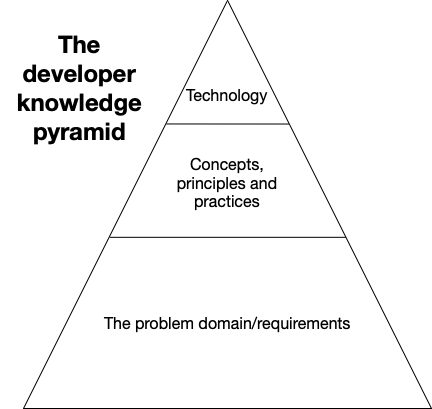The developer's essential knowledge pyramid
Contact me for information about consulting and training at your company.
The MEAP for Microservices Patterns 2nd edition is now available
Until July 25th, enroll for $95 in my virtual bootcamp, distributed data patterns in a microservice architecture
Developing software is difficult. It requires a lot of knowledge. But understanding today’s fashionable technology is insufficient. You also need to understand numerous concepts, principles and practices. But above all, you must have deep understanding of the problem domain. In other words, you need to understand all three layers of the developer knowledge pyramid.

The problem domain
Developers often like to describe themselves in terms of technologies, principles and practices. Today, for example, a fashionable description might be “Socio-technical, full-stack, Java 17 developer”. But while principles and practices are part of the developer knowledge pyramids, it’s far more important to understand the problem domain. If you don’t understand the problem domain, your technical skills are irrelevant. Your perfectly engineered solution will be a failure.
Development concepts, principles and practices
In addition to understanding the problem domain, a developer also needs to numerous (and timeless) concepts, principles and practices. For example:
- Design principles, such as modularity and encapsulation
- Database transaction management concepts such as the meaning of ACID, isolation levels, etc and how to use them
- Design practices, such as evaluating the benefits and drawbacks are possible solutions and selecting the most appropriate one
- Development practices, such as continuous delivery, automated testing, etc.
- …
Without mastering these development concepts, principles and practices, you will most likely be unproductive and develop software that’s poorly designed, unmaintainable and buggy.
Technology
Last and some what least, you need to understand technology. This includes your application’s technology stack (languages, libraries, and frameworks) and the tools that you use to develop, test and deploy it. It’s not good enough to only have a fuzzy understanding of a technology and use it by trial and error. You need to read the manual and have solid mental model of how it works.
An alternative metaphor: developer knowledge tripod
This was based on some interesting feedback on LinkedIn. Perhaps this is a better metaphor:



 Premium content now available for paid subscribers at
Premium content now available for paid subscribers at 




